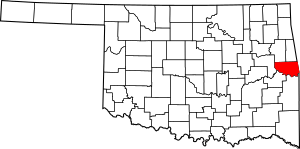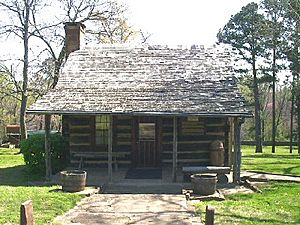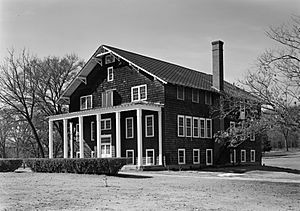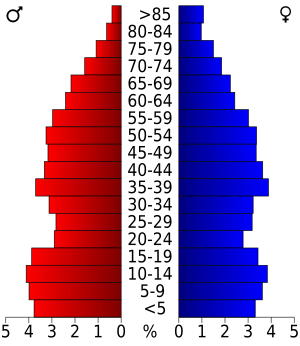Sequoyah County, Oklahoma facts for kids
Quick facts for kids
Sequoyah County
|
|
|---|---|

The Sequoyah County Courthouse in Sallisaw.
|
|

Location within the U.S. state of Oklahoma
|
|
 Oklahoma's location within the U.S. |
|
| Country | |
| State | |
| Founded | 1907 |
| Seat | Sallisaw |
| Largest city | Sallisaw |
| Area | |
| • Total | 714 sq mi (1,850 km2) |
| • Land | 673 sq mi (1,740 km2) |
| • Water | 41 sq mi (110 km2) 5.7%% |
| Population
(2010)
|
|
| • Total | 42,391 |
| • Estimate
(2019)
|
41,569 |
| • Density | 58/sq mi (22/km2) |
| Congressional district | 2nd |
Sequoyah County is a county located in the U.S. state of Oklahoma. As of the 2010 census, the population was 42,391. The county seat is Sallisaw. Sequoyah County was created in 1907 when Oklahoma became a state. It was named after Sequoyah, who created the Cherokee syllabary and its written language.
Sequoyah County is part of the Fort Smith, AR-OK Metropolitan Statistical Area.
Contents
History
Archaeological sites within the borders of the present county date to the Archaic Period (6000 BC to 1 AD). A slightly smaller number of sites date to the Plains Village Period (1000 to 1500 AD).
French traders came to this area in the 1700s, but Spain claimed the area until 1800, when France asserted control. The Louisiana Purchase passed control to the United States. The area was actually inhabited by the Osage Nation until 1816, when Lovely's Purchase occurred, allowing Western Cherokees to settle there before their compulsory removal. The area was then known as Lovely County, Arkansas Territory. However, the Cherokee were removed from Arkansas in 1829 and came to the present Sequoyah County. Sequoyah was among those who moved at the time, building a cabin that still stands. Dwight Mission was also moved to a site on Sallisaw Creek. It also still stands.
The Cherokee Nation established their first capital at a place they called Tahlonteskee (Tahlontuskey), near the present town of Gore, Oklahoma. Tahlonteskee remained the capital until 1839, when it was superseded by Talequah. It continued as a meeting place for "Old Settlers."
This area, then known as the Sequoyah District became a hot bed of Confederate sympathizers during the Civil War. The only combat occurred when Stand Watie and his Confederate troops captured a Union steamboat on the Illinois River June 69, 1864.
Geography
According to the U.S. Census Bureau, the county has a total area of 714 square miles (1,850 km2), of which 673 square miles (1,740 km2) is land and 41 square miles (110 km2) (5.7%) is water.
The county is divided between the Ozark Plateau in the north and the Ouachita Mountains in the south. The Cookson Hills are in the northwest part of the county. The Arkansas River forms the southern border. Other major waterways are the Illinois River and Robert S. Kerr Reservoir.
Major highways
Interstate 40 runs east and west through Sequoyah county. US-59 runs north and south through the county.
Adjacent counties
- Cherokee County & Adair County (north)
- Crawford County, Arkansas (east)
- Sebastian County, Arkansas (southeast)
- Le Flore County (south)
- Haskell County (southwest)
- Muskogee County (west)
National protected areas
- Fort Smith National Historic Site (part)
- Sequoyah National Wildlife Refuge (part)
State protected areas
- Brushy Lake State Park
Demographics
| Historical population | |||
|---|---|---|---|
| Census | Pop. | %± | |
| 1910 | 25,005 | — | |
| 1920 | 26,786 | 7.1% | |
| 1930 | 19,505 | −27.2% | |
| 1940 | 23,138 | 18.6% | |
| 1950 | 19,773 | −14.5% | |
| 1960 | 18,001 | −9.0% | |
| 1970 | 23,370 | 29.8% | |
| 1980 | 30,749 | 31.6% | |
| 1990 | 33,828 | 10.0% | |
| 2000 | 38,972 | 15.2% | |
| 2010 | 42,391 | 8.8% | |
| 2019 (est.) | 41,569 | −1.9% | |
| U.S. Decennial Census 1790-1960 1900-1990 1990-2000 2010-2019 |
|||
As of the census of 2000, there were 38,972 people, 14,761 households, and 10,982 families residing in the county. The population density was 22/km2 (58/mi2). There were 16,940 housing units at an average density of 10/km2 (25/mi2). The racial makeup of the county was 68.12% White, 1.86% Black or African American, 19.64% Native American, 0.22% Asian, 0.03% Pacific Islander, 0.74% from other races, and 9.39% from two or more races. 2.03% of the population were Hispanic or Latino of any race. 95.8% spoke English, 2.1% Cherokee and 1.7% Spanish as their first language.
There were 14,761 households, out of which 34.20% had children under the age of 18 living with them, 58.20% were married couples living together, 11.90% had a female householder with no husband present, and 25.60% were non-families. 22.40% of all households were made up of individuals, and 10.20% had someone living alone who was 65 years of age or older. The average household size was 2.61 and the average family size was 3.05.
In the county, the population was spread out, with 27.40% under the age of 18, 8.20% from 18 to 24, 26.90% from 25 to 44, 24.00% from 45 to 64, and 13.50% who were 65 years of age or older. The median age was 36 years. For every 100 females, there were 97.30 males. For every 100 females age 18 and over, there were 92.50 males.
The median income for a household in the county was $27,615, and the median income for a family was $32,673. Males had a median income of $26,613 versus $19,751 for females. The per capita income for the county was $13,405. About 16.10% of families and 19.80% of the population were below the poverty line, including 24.80% of those under age 18 and 18.10% of those age 65 or over.
Communities
City
- Sallisaw (county seat)
Towns
Census-designated places
Unincorporated communities
NRHP sites
The following sites in Sequoyah County are listed on the National Register of Historic Places:
|
|
 |
Adair County Cherokee County |
 |
||
| Muskogee County | Crawford County, Arkansas | |||
| Haskell County | Le Flore County | Sebastian County, Arkansas |
See also
 In Spanish: Condado de Sequoyah para niños
In Spanish: Condado de Sequoyah para niños




